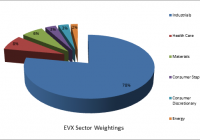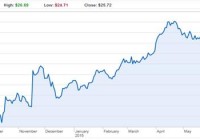NiSource – Red Flags All Around
Summary NiSource’s coal operations have gotten it in trouble before; it won’t be the last. Floundering gross margins have handicapped profitability. Net debt/EBITDA over 4x indicates significant leverage. Nearly $500M in annual interest expense. NiSource (NYSE: NI ) is a provider of natural gas and electricity to customers across seven states. The company touts its long-term return potential, citing strong local market growth, geographic diversity, and sizeable upgrade potential on its existing infrastructure, on which it would be entitled to a fair return on its investment. NiSource recently completed a spin-off of its Columbia Pipeline (NYSE: CPGX ) business, which means the new NiSource generates nearly 100% of its revenues from regulated utility operations. This fact, plus management’s guidance of 4-6% annual dividend growth from here on out, has drawn in income investors that have been searching for low-risk, stable income options in a highly volatile market. Is NiSource deserving of this praise, or are there potential bumps in the road for the company in the years ahead? Columbia Pipeline Spin-Off NiSource completed the spin-off of Columbia Pipeline Group in early July. Pitched to shareholders as unlocking value by separating two distinct businesses into independently run, pure-play public companies. Shareholders bought the idea hook, line, and sinker. Columbia Pipeline owns an extensive route of pipelines connecting the Northeast Marcellus/Utica shale plays to important local locations along with hundreds of billions of cubic feet of natural gas storage. Customers are primarily contracted, fee-based giants in the energy/utility business such as Exxon Mobil (NYSE: XOM ) and Dominion Resources (NYSE: D ). The prospect of management-guided 20%+ annual EBITDA growth on a seemingly ever expanding domestic energy market drew in investors chasing big capital gains and solid dividends. Unfortunately for shareholders of this new entity, the market has sold off highly leveraged midstream energy MLPs like Columbia Pipeline (along with peers like Kinder Morgan (NYSE: KMI )) on fears related to the sustainability and growth potential of American energy production. Smaller companies like Columbia Pipeline have been more adversely affected by the sell-off; shares are down 40% in a few short months compared to a flat performance from the S&P 500. This lesson in volatility has likely been a tough pill to swallow for dividend investors who have likely grown used to relatively mild movements in price. While I think midstream MLPs have been oversold and selling here would be a mistake, investors should likely consider paring down exposure to Columbia Pipeline as the share price recovers. Pro-Forma Operating Results Unfortunately for shareholders, NiSource has done a mediocre job regarding transparency of breaking out Columbia Pipeline’s contribution to NiSource’s earnings results on its presentations. This is necessary for investors to properly evaluate how the utility business has been performing over the past few years. After digging around in the SEC filings, I’ve broken out NiSource’s utility operations above given its pro-forma Columbia Pipeline filings given here . Total revenue has grown marvelously, but gross margins have contracted. NiSource has never been known for efficient operations and that trend has continued into recent years. This has always been a concern for investors. Another concern with the company is its electric operations, which generated approximately 30% of total utility revenues in 2014. The vast majority of available power generation (2,540MW of 3,281MW, or roughly 77% of power generation) is fired by coal. Energy mix has been unchanged for years, and given my pessimistic outlook on coal, my opinion here should be obvious. With such a high percentage of ageing coal power plants, it is likely only a matter of time before these plants reach the same fate as the company’s Dean Mitchell Generating Station, which was shut down in a settlement with the Obama Administration. This agreement also led to the company being forced into $600M in infrastructure upgrades on these old coal plants. The company had avoided provisions that required these upgrades for years. Even pro forma to exclude the buildup in the Columbian Pipeline infrastructure over the past few years, NiSource has been a serial burner of cash and a big issuer of debt – the combined company has issued billions in debt over the past few years to cover cash flow shortfalls. After the spin-off, NiSource is being left with a $5.5B long-term debt load. With EBITDA falling in the $1.3B range for 2015, net debt/EBITDA will be a hair over 4x. This is manageable for a utility, but investors should be cautious, especially given likely capital expenditure requirements for NiSource to maintain and update its prior-mentioned aging coal power plants. Conclusion Management here has the opportunity for a fresh start towards operating a functional utility. Improving gross margins, investing in its business smartly, and paying down its debt. Unfortunately, the company is more like a three-legged chair at the moment – the very foundation of the company is wobbly. Coal-fired generation puts a target on the company’s back. Nearly $500M in annual interest expense cuts operating profit off at the knees. With the company trading at nearly 18x 2016 earnings estimates, shares aren’t cheap compared to peers. Fair value is closer to 15x 2016 earnings of $1.03/share, or $15.45/share. In my opinion, investors would be wise to avoid NI’s shares currently.

